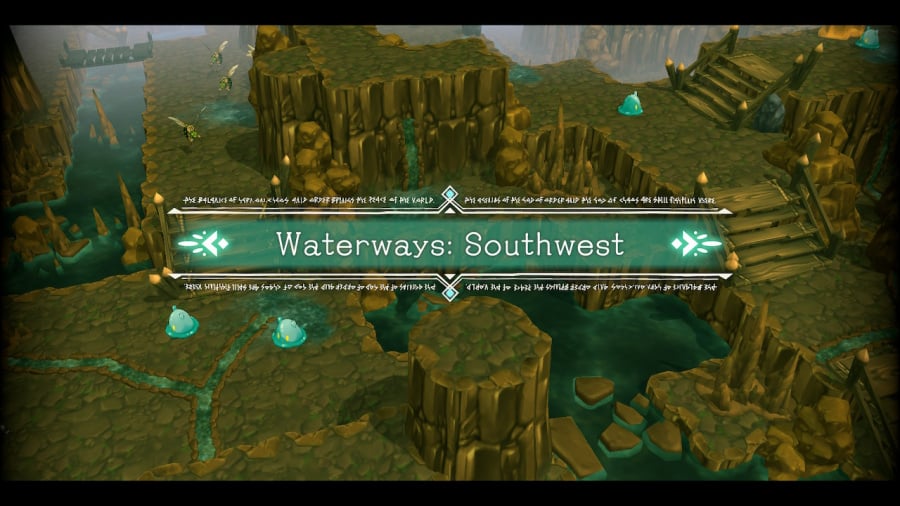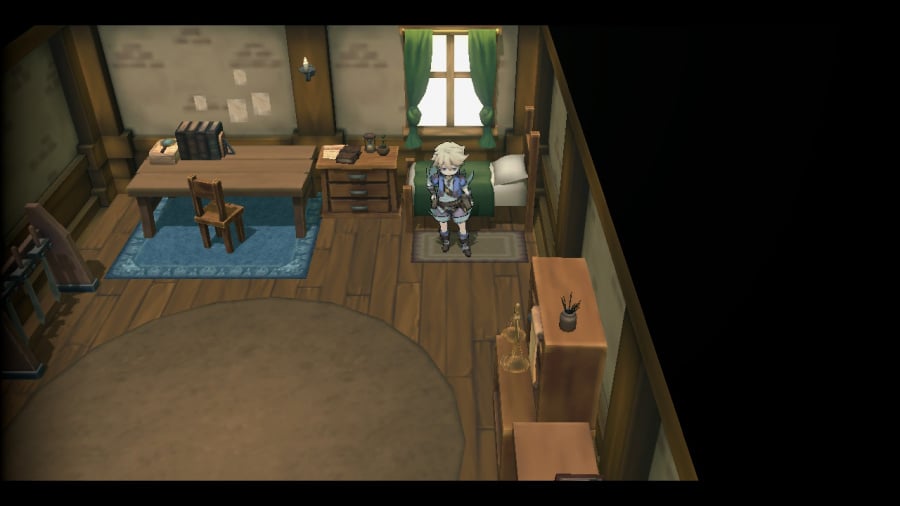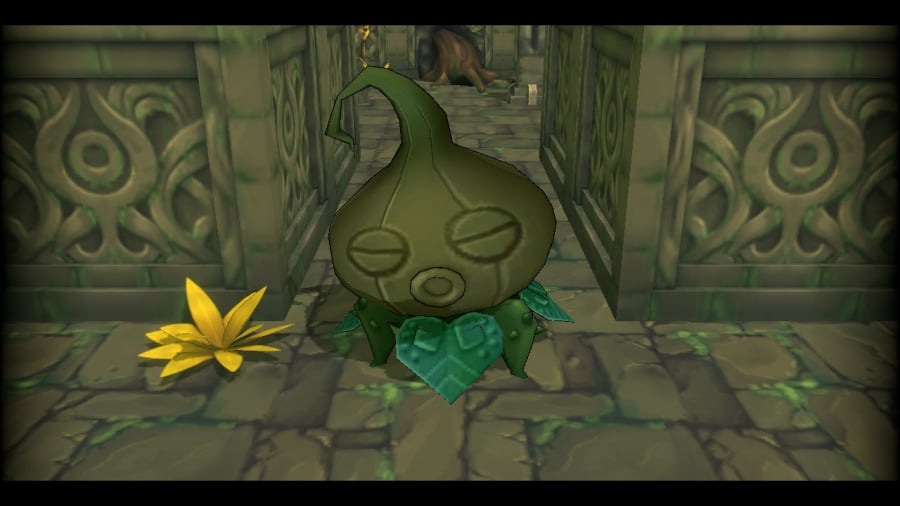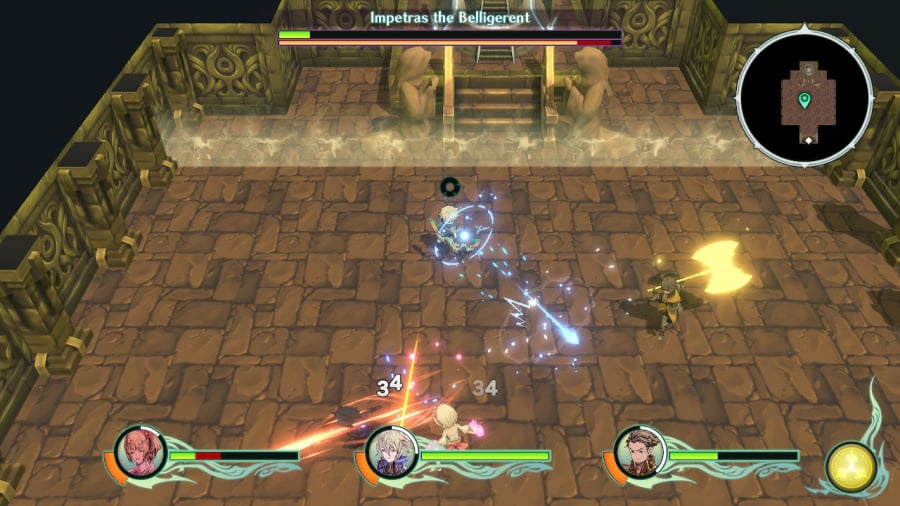Fans of ’90s JRPGs, particularly those released for the SNES, will have been watching Trinity Trigger closely. The game boasts a veritable dream team from some of the best JRPGs of the past 30 years, including those who worked on Xenoblade Chronicles, Octopath Traveler, and, of course, Secret of Mana. There is a lot for Trinity Trigger to live up to; fortunately, it managed to exceed our expectations in most areas.
The world of Trinitia is at the centre of an unending war between the Gods of Order and the Gods of Chaos. To prevent destroying everything in their conflict, the gods agreed to choose a champion and have them fight in their stead, but not before several of their weapons, called Arma, were scattered along the surface. Giant spears, axes, and swords have become home to monsters and scavengers alike, while the gods wait to see whether the Warrior of Chaos or Order will prevail.
It is a simple setup for the game’s plot, but it does a good job setting the stage for the adventure that unfolds. Our hero, Cyan, is the Warrior of Chaos, which isn’t painted as a force for evil in this setting. Instead, chaos is seen as freedom, while order is most stifling and controlling. Forces conspire to keep Cyan from fulfilling his destiny to keep the war between the gods going as long as possible. Their goal is to murder one of the champions before their climactic battle can be waged.

Cyan is joined by Elise and Zantis, both of whom are drawn to helping him on his quest due to the influence of one of the world’s gods. The three heroes are bound to Triggers, strange beings that can transform into weapons in battle. The Triggers can unlock new forms by exploring the weapons of the gods, which forms the basis for the game’s main quest. Visit new Arma to unlock new weapons while trying to keep Cyan from being killed. Rinse and repeat until you unlock all eight weapons for each character.
The plot feels slightly too straightforward at times, with the string guiding you from dungeon to dungeon tugging a little too tightly. The world, as bright and colourful as it is, never quite feels open enough to get lost in. We’re told that Cyan is in mortal danger, but it never feels like that danger is present enough to make us fearful. The side quests tend to be shallow and simple, with simple rewards that don’t offer much incentive to complete them. None of it is bad, but it feels like they could have had more meat to them. There is a touch of nuance to how the game explores good and evil, but it doesn’t tend to go much deeper than the surface level.
Where Trinity Trigger succeeds is in its combat and design. Fans of Secret of Mana or even Secret of Evermore will see plenty of similarities here; weapons or items can be chosen from ring menus and players can switch between controlling one of the three characters whenever they like. You can even engage in some good, old-fashioned local co-op, which we would encourage because the AI-controlled characters make some baffling choices at times. They are good at avoiding the enemy’s obviously telegraphed attacks but will repeatedly walk directly into a spike trap without a second thought. AI-controlled characters also never use their powerful Trigger Strikes or Weapon Auras, making them significantly less powerful.

Multiplayer doesn’t unlock until around two hours into the game, once you’ve recruited all three characters to your party. It is local only and can be switched on and off from the game’s main menu. There are some foibles that we didn’t expect, such as only the lead player being able to open chests or talk to NPCs, but overall it made Trinity Trigger a better experience to play through.
It would have been easy for the team to rely solely on nostalgia to fuel Trinity Trigger’s appeal. The combat feels familiar but avoids becoming a simple rehash of what we’ve already seen. The music was instantly recognisable as Hiroki Kikuta’s work, with several songs sparking deep memories of the Mana series, but doesn’t feel stale or dated. As much as this game wants you to know that it is banking on nostalgia, it never relies on it fully. There is plenty here to make it a great JRPG experience all on its own.
Battles are played out in realtime, with players hitting enemies with strings of attacks so long as their action gauge remains full. Certain weapons drain that gauge faster or do more damage than others, so you can pick and choose which ones work best for you. There is no magic system in the game, so these weapons are the sole source of power for the characters. You can choose what combination of moves each weapon uses and what stats their equipment will buff, giving Trinity Trigger a limited but adequate sense of customisation.

Sprinkled among the regular enemies are boss fights, which introduce an armour gauge that must be depleted before their hit points can be directly attacked. Most of them have a weakness to certain weapons, but they can feel like a slog even when you fully exploit those weaknesses. None of them feel properly challenging, giving you plenty of warning before they unleash a major attack so you can roll out of the way. We only died once in our playthrough of the game, which might make it a touch on the easy side for some.
Thankfully, the legendary grinding required for many ’90s JRPGs isn’t necessary here. Every weapon in a character’s arsenal shares a pool of points that you can use to level them up, so you can focus only on the weapons they use and the skills they have equipped. It is a more efficient system that lends itself to the game’s shorter runtime. It took us around 25 hours to complete Trinity Trigger’s main plot, though you can pad that out by completing the side quests or levelling up all of your skills.
The cutscenes that play at key moments in the game are beautiful to watch, with a kind of hand-painted anime feel that feels straight out of a picture book. The character portraits that are shown during most conversations are of this style, which makes up for how simplistic the animation generally is. Trinity Trigger isn’t trying to push the boat out when it comes to visuals, but what it does works well enough that you won’t mind. We ran into a couple of frame rate issues twice during our time with the game, both times in handheld mode.

Trinity Trigger is clearly looking to bank on fans’ nostalgia for ’90s JRPGs, but it doesn’t make the mistake of relying solely on it. The characters are fun. The art and design are beautiful. The combat feels familiar enough with being derivative. Despite some repetitive dungeon designs and a plot that doesn’t hold many surprises, Trinity Trigger is a great throwback to a golden era of JRPGs.
Conclusion
JRPG fans can rest easy knowing that Trinity Trigger will meet their lofty expectations; this is a nostalgia trip worth taking. While not perfect, with beautiful art and music and a combat system that will feel both fresh and familiar, it is a strong contender for one of the best JRPGs of 2023 so far. The plot isn’t anything to write home about and it’s a tad on the easy side, but it remains engaging, especially for Mana series enthusiasts. Hopefully its proximity to the launch of The Legend of Zelda: Tears of the Kingdom doesn’t see Trinity Trigger overshadowed before it gets a chance to shine.
Read the full story at: Source link
